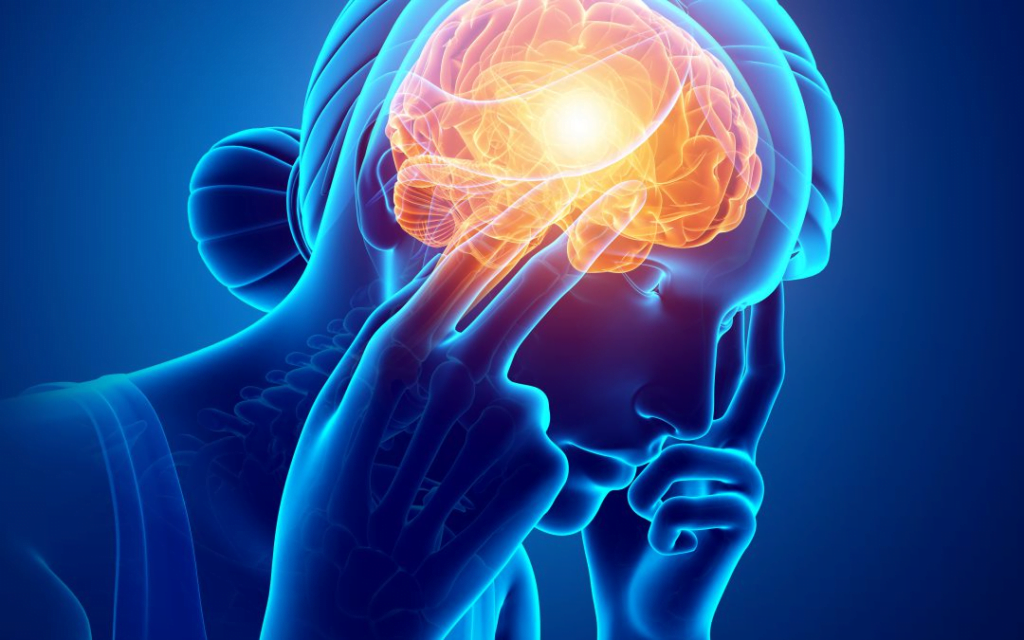“A migraine can cause severe throbbing pain or a pulsing sensation, usually on one side of the head. It’s often accompanied by nausea, vomiting, and extreme sensitivity to light and sound. Migraine attacks can last for hours to days, and the pain can be so severe that it interferes with your daily activities” (Mayo Clinic, 2020).
What causes a migraine?
“Though migraine causes aren’t fully understood, genetics and environmental factors appear to play a role. Changes in the brainstem and its interactions with the trigeminal nerve, a major pain pathway, might be involved. So might imbalances in brain chemicals — including serotonin, which helps regulate pain in your nervous system. Researchers are studying the role of serotonin in migraines. Other neurotransmitters play a role in the pain of migraine, including calcitonin gene-related peptide (CGRP)” (Mayo Clinic, 2020). While the causes are unknown, there are a handful of factors that can trigger a migraine. These triggers include hormonal changes in women, hormonal medications, alcoholic or caffeinated drinks, work or home stress, sensory stimuli (bright lights, loud sounds, strong smells), sleep changes, physical factors (intense physical exertion, including sexual activity), weather changes, certain medications (differs per patient), certain foods, changes in eating pattern, and food additives. (Mayo Clinic, 2020).

What are the symptoms of a migraine?
“Migraines, which often begin in childhood, adolescence or early adulthood, can progress through four stages: prodrome, aura, attack and post-drome. Not everyone who has migraines goes through all stages” (Mayo Clinic, 2020). In the prodrome stage, a patient may experience “constipation, mood changes, food cravings, neck stiffness, increased thirst and urination, and frequent yawning” either one or two days before experiencing the migraine. In the aura stage, a patient may experience seeing an aura right before or during their migraine. “Auras are reversible symptoms of the nervous system. They’re usually visual, but can also include other disturbances. Each symptom usually begins gradually, builds up over several minutes and lasts for 20 to 60 minutes. Examples of migraine aura include: visual phenomena, such as seeing various shapes, bright spots or flashes of light, vision loss, pins and needles sensations in an arm or leg, weakness or numbness in the face or one side of the body, difficulty speaking, hearing noises or music, uncontrollable jerking or other movements” (Mayo Clinic, 2020). In the attack stage, a patient may experience “pain, usually on one side of your head, but often on both sides, pain that throbs or pulses, sensitivity to light, sound, and sometimes smell and touch, nausea and vomiting. A migraine usually lasts from four to 72 hours if untreated. How often migraines occur varies from person to person. Migraines might occur rarely or strike several times a month” (Mayo Clinic, 2020). In the postdrome phase, a patient may “might feel drained, confused and washed out for up to a day. Some people report feeling elated. Sudden head movement might bring on the pain again briefly” (Mayo Clinic, 2020).

How does one treat a migraine?
There are a few things a patient can do at home to try to alleviate migraine symptoms. It is ideal to be in a relaxing environment when experiencing a migraine. The patient should go into a dark, quiet room, as light and sound typically aggravate the migraine. Sometimes, the use of a hot or cold compress can alleviate some of the pain and discomfort. Drinking caffeinated beverages can also help alleviate pain and pressure although additives in caffeinated drinks can make migraine worse. The use of Advil, Tylenol, or aspirin may also reduce pain and any inflammation in the affected area. For prevention & conservative treatment, weekly chiropractic adjustments are recommended. Manual therapy or massage therapy can also aid in preventing migraines. One should be sure to drink plenty of water throughout each day, as being dehydrated can cause migraine headaches. One should also be sure to eat a well balanced diet and get enough sleep each night. Managing one’s stress can be extremely beneficial in preventing migraines. Taking short breaks to relax throughout the day can be helpful. Mayo Clinic (2020) suggests that patients should keep a “migraine diary” on hand to track and report migraine attacks. “A diary may help you determine what triggers your migraines. Note when your migraines start, what you were doing at the time, how long they last and what, if anything, provides relief” (Mayo Clinic, 2020). If migraines do not resolve with conservative care a multidisciplinary approach with a neurologist & medication management may be necessary.
Work Cited
Migraine. (2020, January 16). Retrieved July 14, 2020, from https://www.mayoclinic.org/diseases-conditions/migraine-headache/symptoms-causes/syc-20360201
*, N. (2019, July 08). Have You Thought About Your Diet When You Think About Your Migraines? Retrieved July 15, 2020, from https://www.immunolabs.com/have-you-thought-about-your-diet-when-you-think-about-your-migraines/
